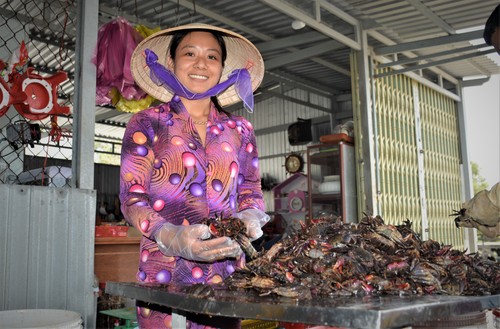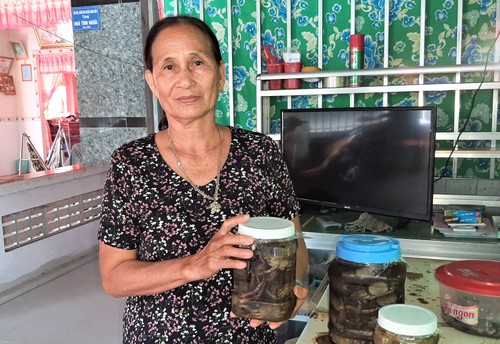 Salted ba khia is a culinary specialty of Ca Mau province. (Photo: VOV) Salted ba khia is a culinary specialty of Ca Mau province. (Photo: VOV) |
Making salted fermented crab has been going on for a long time in Ca Mau, Vietnam’s southernmost province, and is now done mainly in the coastal districts of Dam Doi, Phu Tan, Nam Can, and Ngoc Hien. The most famous ba khia comes from Rach Goc town in Ngoc Hien district.
Rach Goc three-striped crab is particularly delicious because of the local conditions in which the crabs live, says Nguyen Hong Dam, who has made salted ba khia for many years as a household business.
"Ba khia is popular throughout the southern coastal province of Bac Lieu and many districts in Ca Mau province, but Rach Goc striped crab is the most delicious because of the mangroves and alluvium in this area. The food the crabs eat here makes them delicious, sweet, and thick," said Dam.
Years ago three-striped crabs were very plentiful. During the crab season, from the seventh to the ninth lunar month, the crab catch was so plentiful that the locals were forced to preserve all the excess crabs with salt.
For generations, the basic steps for salting the crabs have remained unchanged. But in the past, crab fishermen carried jars of salt water and whenever they caught a crab, they washed it and put it immediately into a jar of salt water. The next morning, the crabs were taken out, dried, and transferred to a new jar of salt water, which would be tightly covered until it was time to eat the crabs.
Today the crabs aren’t immediately salted after they’re caught. They’re left to become thirsty. Then, when they’re put in a jar of concentrated salt water, they drink the salt water and the salt water they drink preserves them longer and gives them a better flavor. Later, the jar is drained, the crabs are washed and then arranged in layers in the empty jar. Then new salt water is added.
Luong Van Binh, whose household in Rach Goc town is experienced in salting striped crabs, said, “New salt water is used for each step. After the crabs are washed, they need a new jar of salt water. If the salt water is not concentrated enough, the crab will spoil. The salt water is the key.”
With too little salt, the crab will spoil. With too much salt, the crab will be rejected by the customers. The salted crab is often eaten with lemon, garlic, chili, pineapple, and sugar, to make it less salty and more delicious.
 Salted ba khia is much sought after in the market. (Photo: VOV) Salted ba khia is much sought after in the market. (Photo: VOV) |
La Quoc Khanh, Vice Chairman of Ngoc Hien district Farmers' Association, says Ca Mau province's salted striped crab is so popular that demand always exceeds the supply.
"Three-striped crabs live in the mangrove forests. Southerners eat the crabs year-round. Crab businesses should work with the authorities to build brands. When producers have certificates and a reputation, they can more easily sign large contracts," said Khanh.
Being recognized as a national intangible cultural heritage last year has made salted three-striped crab more popular. The provincial Department of Culture, Sports and Tourism and the Ngoc Hien district People's Committee plan to form craft villages to promote salted ba khia as a local specialty product.